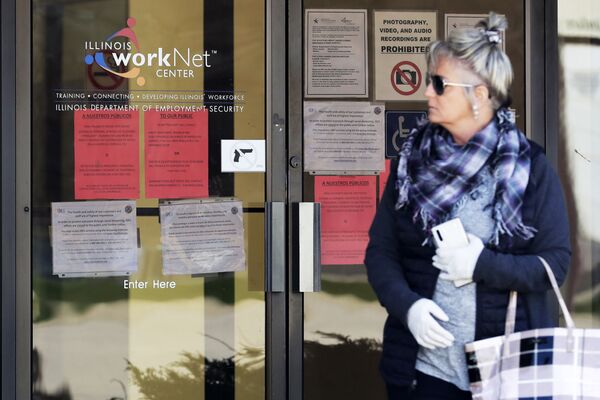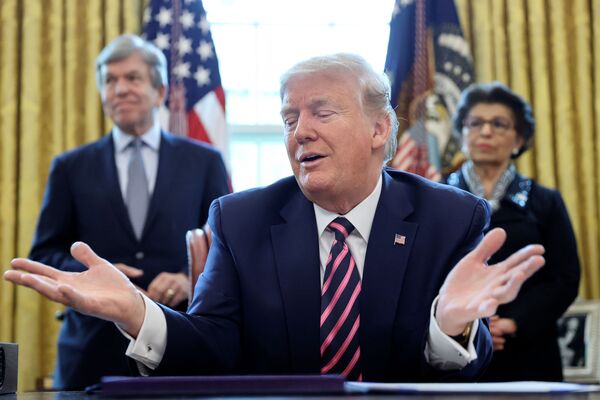The US is predicted as heading for an unemployment rate comparable to the levels registered during the Great Depression of 1929 – 1939, as it struggles to deal with the fallout from the novel coronavirus pandemic.
"Around 2008, we lost 8.7 million jobs and the whole thing. Right now, we're losing that many jobs about every 10 days," said Kevin Hassett, President Donald Trump's economic adviser, on ABC's "This Week" on 26 April.
The adviser recalled that during the Great Depression, unemployment rate peaked at about 25 per cent, while during the Great Recession of 2007- 2009 it took roughly 10 months for new unemployment claims to spiral as high as they currently have in under a month.
In staggering statistics, 4,427,000 Americans filed for unemployment benefits after losing their jobs in the week ending 18 April, according to the US Department of Labor, bringing the current number of those who filed claims since mid-March to 26.5 million.

The developments triggered by the coronavirus pandemic and measures introduced in an effort to slow the spread of the respiratory disease brought to an end a period of over 100 months of uninterrupted job growth, according to economists.
In a number that experts predict will grow further, the unemployment rate was at 11.3 percent during the week ending 11 April, while just two months ago, in February, it was at around 3 percent.
According to James Knightley, chief international economist at ING, if another 10 million Americans file jobless claims in May, that would push the unemployment rate to 22 percent.
“The initial wave of job losses were concentrated in the retail and hospitality sectors, but that’s spreading to suppliers and other industries,” Knightley was quoted by Business Insider as saying.
Some economists are cited as forecasting a further growth of unemployment claims fuelled by a coronavirus-weakened economy against the backdrop of closed businesses and a self-isolating population.
While up until now job losses primarily targeted the lower-wage, blue-collar- workers, experts see the dynamics eventually engulfing white-collar professionals as well.
“At this point it would take a miracle to keep this recession from turning into the Great Depression II. It is going to take years not months to put these pandemic jobless workers back to work at the shops and malls and factories and restaurants across the country,” Chris Rupkey, MUFG managing director and chief financial economist, wrote in a note on 23 April.
Repercussions of Job Loss
On a broader scale, negative unemployment statistics could bring about devastating fallout for the economy, taking into consideration the fact that consumer spending makes up 70 percent of US gross domestic product, which is predicted by JPMorgan to plummet by 40 percent in the second quarter.
Retail and home sales have been slumping as the pandemic shows no sign of abating and job loss continues.
Big banks have been offering their assessment of the looming economic hardships from the pandemic-triggered slowdown.
JPMorgan Chase & Co. predicted gross domestic product could decline 40 percent with unemployment spiking to around 20 percent this quarter, while Bank of America Corp. forecast a slump that might drag on into next year.
As the Morgan Stanley team of economists expects real GDP contracting 5.5 percent in 2020 – the most significant drop since 1946, they add:
“We expect the U.S. economic recovery will be more drawn-out than previously anticipated, marked by a deeper drop into recession and slower climb out.”
Rush to Mitigate COVID-19 Impact
In an attempt to alleviate the devastating impact of the coronavirus pandemic, on 23 April US Congress approved the $484 billion aid package to help small businesses, hospitals and first responders – the fourth such bill since the beginning of the crisis.

The relief bill amends the bipartisan-backed Coronavirus Aid, Relief, and Economic Security (CARES) Act and provides a $310 billion expansion to the authorization level of the Paycheck Protection Program (PPP).

The PPP was set up to prop up small American businesses through loans subsequently forgiven if staff remain on payroll for a period of eight weeks and funds are used for payroll, mortgage interests, utilities or rent.
Business Activity at New Lows
US business activity dropped to record lows in April as the novel coronavirus disrupted manufacturing and services industries.
According to data firm IHS Markit, on 23 April its flash US Composite Output Index, which tracks manufacturing and services sectors, had dropped to 27.4 in the lowest reading since the series began in late-2009.
According to an optimistic scenario, growth might begin in the third quarter, but by the end of the year only one third of spring losses could expected to be compensated.
Hopes for a quick, or V-shaped economic recovery, laid down in most official forecasts, are deemed unlikely by many experts.
“Net, net, jobless claims are warning that the worst isn’t over yet for the American economy with businesses and consumers alike being sucked down into the abyss of the pandemic recession. The risks to the outlook are that the economy is digging itself such a big deep hole that its ill become harder to climb back out of it,” concludes MUFG managing director Chris Rupkey.




